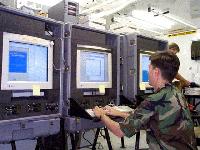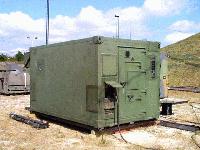







 The Ground Theater Air Control System (GTACS) provides the ability to rapidly detect and identify airborne targets with minimal or no support. The TYQ-23 (V2) is commonly referred to as the "Production" version and the TYQ-23 (V3) is known as the "P3I" version. GTACS brings a combination of range, precision, low signature and control to the war fighter's arsenal. GTACS provides the capability to hold at risk an enemy's war-making potential. Additionally GTACS can be deployed in two or more configurations; each suited to hold emerging targets at risk through an integrated air defense control system. This makes possible the rapid deployment of assets tailored to countermeasure a wide range of threats.
GTACS can be worldwide deployable to any number of fixed base sites. Deployment in either a Control Reporting Center or Control Reporting Element configuration represents the assemblage of considerable resources. Back-shop support is normally not deployed with some exceptions. For these reasons a reduced deployment footprint is critical. Maximizing the use of digital data will help reduce this footprint.
The Automated Air Tasking Order [AATO] software application is configured from non-developmental Commercial off-the-shelf (COTS) hardware and both COTS and government-developed software to provide the MCE unique ATO message handling and interface processing. The AATO application’s electronic data processing hardware and software consists of a TBMCS remote workstation augmented with AATO unique software to control the overall AATO process and to interface with the MCE to make the data available to the CRC/CRE air surveillance, identification and weapons a control functions. In addition to the AATO functionality, the AATO operator may use the functions provided by the TBMCS remote workstation. The AATO functionality will provide the AATO operator with the ability to select ATO messages transmitted over the TBMCS WAN for automatic or semi-automatic processing. Also, the AATO operator will have the ability to review and edit the ATO data contained in the MCE database.
The Ground Theater Air Control System (GTACS) provides the ability to rapidly detect and identify airborne targets with minimal or no support. The TYQ-23 (V2) is commonly referred to as the "Production" version and the TYQ-23 (V3) is known as the "P3I" version. GTACS brings a combination of range, precision, low signature and control to the war fighter's arsenal. GTACS provides the capability to hold at risk an enemy's war-making potential. Additionally GTACS can be deployed in two or more configurations; each suited to hold emerging targets at risk through an integrated air defense control system. This makes possible the rapid deployment of assets tailored to countermeasure a wide range of threats.
GTACS can be worldwide deployable to any number of fixed base sites. Deployment in either a Control Reporting Center or Control Reporting Element configuration represents the assemblage of considerable resources. Back-shop support is normally not deployed with some exceptions. For these reasons a reduced deployment footprint is critical. Maximizing the use of digital data will help reduce this footprint.
The Automated Air Tasking Order [AATO] software application is configured from non-developmental Commercial off-the-shelf (COTS) hardware and both COTS and government-developed software to provide the MCE unique ATO message handling and interface processing. The AATO application’s electronic data processing hardware and software consists of a TBMCS remote workstation augmented with AATO unique software to control the overall AATO process and to interface with the MCE to make the data available to the CRC/CRE air surveillance, identification and weapons a control functions. In addition to the AATO functionality, the AATO operator may use the functions provided by the TBMCS remote workstation. The AATO functionality will provide the AATO operator with the ability to select ATO messages transmitted over the TBMCS WAN for automatic or semi-automatic processing. Also, the AATO operator will have the ability to review and edit the ATO data contained in the MCE database.
Ground-based C2 elements of the Theater Air Control System supporting air operations performed by the Combat Air Forces provide JFACC with means to plan, direct, and control air operations and coordinate these air operations with ground, naval, and coalition forces.
Major GTACS functions include:
The AN/TPS-75 Radar System provides a "real-time" radar airspace picture and data in support of the battle commander and the Ground Theater Air Control System (GTACS) via radio, telephone, microwave relay, or satellite communications link.
The keystone of the Ground Theater Air Control System (GTACS) is the AN/TYQ-23 Modular Control Equipment (MCE), an automated computer-based information system operating in a proprietary environment that provides a variety of automated information functions such as aircraft surveillance, flight follow, control, and communication functions within the GTACS. AN/TYQ-23 Modular Control Equipment (MCE) production provided 75% of USAF functionality requirement. P3I development effort provides MCE JTIDS capability upgrades to existing radio/digital interfaces and enhanced software capabilities. Software sustainment for MCE, JM, MIG and associated C2 equipment maintains currency with operational requirements and correct deficiencies. Litton Data Systems MCE P3I Production and installation of P3I upgrade kits, including JTIDS, ARC-186 and VRC-89 radios, and numerous enhancements, to all operational Oms, TPS-75 Radars, and fixed sites (training and maintenance). Fielding of the P3I OM and Radar kits developed under ECP-10, produced and installed under P3I production. Effort includes coordinating fielding of the JM and related products, and interfacing with the CAF Agency. JTIDS Modules (JM) are modified S-711 comm shelters (US Army Regency Net) designed to interface with the P3I MCE OM. JM shelters contain various comm equip and interfaces with MCE via Tri-Service Tactical (Tri-Tac) link. JTIDS Module provides for development and delivery of 5 JTIDS Modules which will be interfaced with the P3I MCE OM to establish a Link-16 capability. This program also procured all JM Production long lead items and Technical Packages. Northrup-Grumman's Expert Missile Tracker (EMT) will provide integrated capability to detect / track TMDs via AN/TPS-75 Radars, and interface to Tactical Air Operations Modules at CRCs / CREs. Automatic Radar Eval System & Jammer Test Set (ARADES IV) by Northrup-Grumman (Westinghouse) is portable PC based test set that performs calibration, performance evaluation (including ECCM), and maintenance diagnostics for the AN/TPS-75 Tactical Radar. The Combat Integration Capability (CIC) Provide acquisition support for Comm Suite portion of CIC upgrade to the AOC/CRC. JTIDS TMD Message Set Integration by Carlisle Research develops GTACS-JTIDS TMD capability.MCE has numerous upgrades, interfaces, and integration efforts underway with the goal of meeting DISA guidelines and consistent with their application in GCCS, Contingency Theater Automated Planning System (CTAPS), Theater Missile Defense (TMD) and Theater Battle Management (TBM). One upgrade is the MCE operator console unit which is targeted to be a common work station, which can be removed from MCE and used in various applications including incorporation into GCCS COE as a core application. The MCE migration strategy involves replacing the AN/AYK-14 computer with commercial processors and replacing the proprietary Digital Data Bus (DDB) with a commercial Local Area Network (LAN). Also planned is the replacement of GCCS software with software being developed for the Regional/Sector Air Operations Center (R/SAOC) program.
The GTACS Combat Information Center (CIC) is targeted as an application for the common work station. The CIC could become a GCCS based MCE using the common work station, interfacing with the MCE closed architecture over a gateway. Additionally, the Joint Tactical Information Distribution System (JTIDS) capability would be included in the CIC in conjunction with a front end TADIL message processor. This would allow for easy transition to a common computer (eliminating the current MCE AN/AYK-14 computer and its associated logistics support costs) and opening up the MCE architecture for use with GCCS. The applications within MCE and the GTACS for migrating towards the GCCS are numerous. As the MCE Migration Strategy Report is revised and updated, more GTACS/MCE applications for migration to GCCS will be identified, documented, and implemented.




